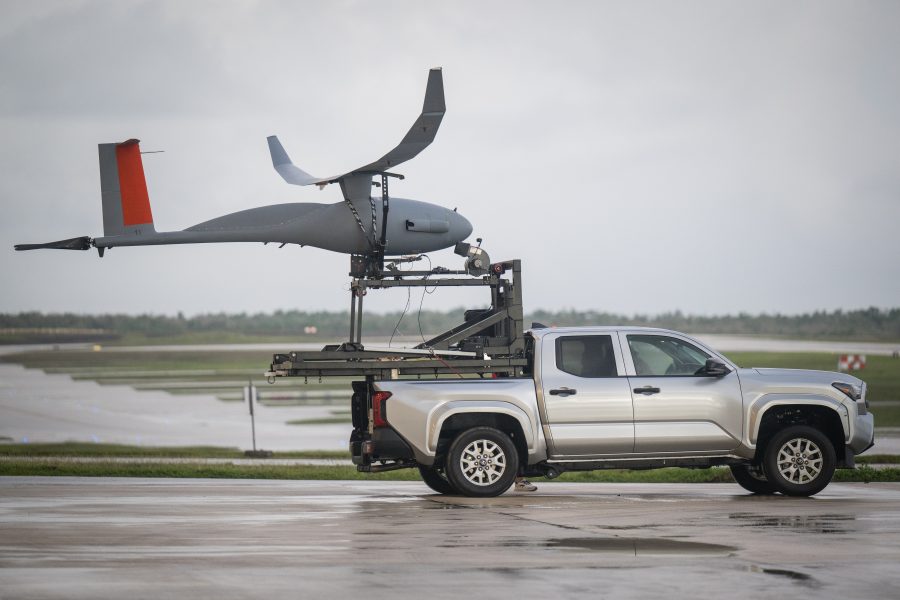The Pentagon’s science and technology office is investing to develop new solutions for defending far-flung bases, controlling satellites in space, and enabling autonomous drones to collaborate, said Acting Assistant Secretary of Defense for Mission Capabilities Thomas Browning.
Browning’s office oversees the Rapid Defense Experimentation Reserve (RDER), launched in 2021 to tackle “joint problems, those areas that fall into the gaps,” he said at the Hudson Institute. The program funds prototyping and experiments for technologies that could later be transferred to the services, where they would become programs of record.
RDER was created to answer needs identified by the Combatant Commands that couldn’t be answered with existing solutions. Heidi Shyu, undersecretary of defense for research and engineering, speaking not long after the program started said it was, for “the first time, fulfilling a COCOM’s capability shortfall at the joint level.”
Most RDRER projects are classified, but Browning did say the projects operated in two-year “classes,” with a focus on specific missions or challenges. The first “class” focused on long-range fires for the Pacific. Browning said RDER took on 23 projects, but did not offer further details except to say four of the 23 successfully transitioned to the services and will become programs of record. Another dozen or so could still move forward, he said.
“Of 23, probably six-ish are not going to transition right away—that’s amazing math,” he said. But the Senate Appropriations Committee is less sanguine about RDER’s success. Its version of the 2025 defense spending bill, released in August, criticized RDER, saying it “could be better positioned” and failed to transition enough programs in 2023. That measure would cut funding.
Browing professes confidence howerver, explaining that the program will take an “enduring look at the INDOPACOM fight” in 2025, empasizing disrupting adversary kill chains and assuring U.S. combat effectiveness. In 2024, the program focused on “underserved” categories, including contested logistics and base defense.
“We got some amazing inputs,” Browning said. “We had inputs from the J4 where quite often logistics aren’t even allowed at the table. And so we got a nice list of very logistics-focused activities, a nice list of forward base defense activities, and we’re executing the prototyping on those right now.”
Both are important to the Air Force. Air Mobility Command has spent months working on how to surge forces to the Pacific in the event of a conflict with China and concerns about base defense span the gamut, from combat commanders to mobility chiefs.
The Air Force expects to disperse units to remote airfields, highlighting some of the issues RDER is trying to address: Base defense is an Army mission and the Air Force has been working with the Army for months to make that work. Chief of Staff Gen. David W. Allvin, asked at the recent Military Reporters and Editors conference if the Air Force would be willing to share costs with the Army for air defense assets, demurred, as the primary mission for base air defense falls to the Army.
Looking ahead to 2026, leaders just recently selected the two areas it will focus on: space control and support for the terrestrial fight, and autonomous collaboration.
“How am I leveraging space to help that joint fight fully evolve” as low Earth becomes crowded with thousands of satellites, Browning said. “And then the second one … was this idea, if we’re going to put a whole bunch of unmanned vehicles out there in the forward edge of the fight, how are they not killing each other? How are they talking to each other? How are they synchronizing?”
While the first of these projects will inevitably involve the Space Force, the matter of coordinating drones is of intense interest to the Air Force, which is developing Collaborative Combat Aircraft that can team with manned platforms. RDER, however, will focus on a missing capability in the U.S. arsenal, drones that work together “independent of human interaction.” Sometimes called drone swarms, these closely coordinated aircraft could be highly effective at shutting down airports or creating hazards to disrupt base operations.
